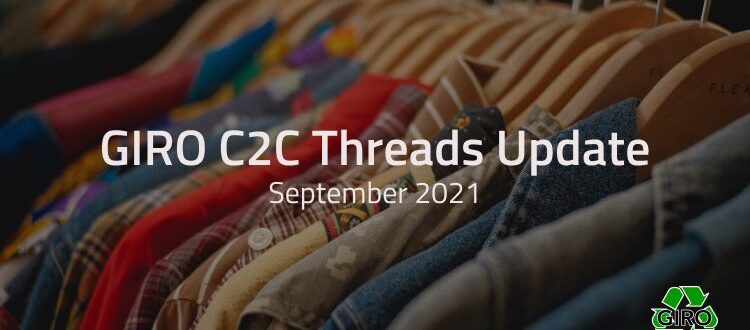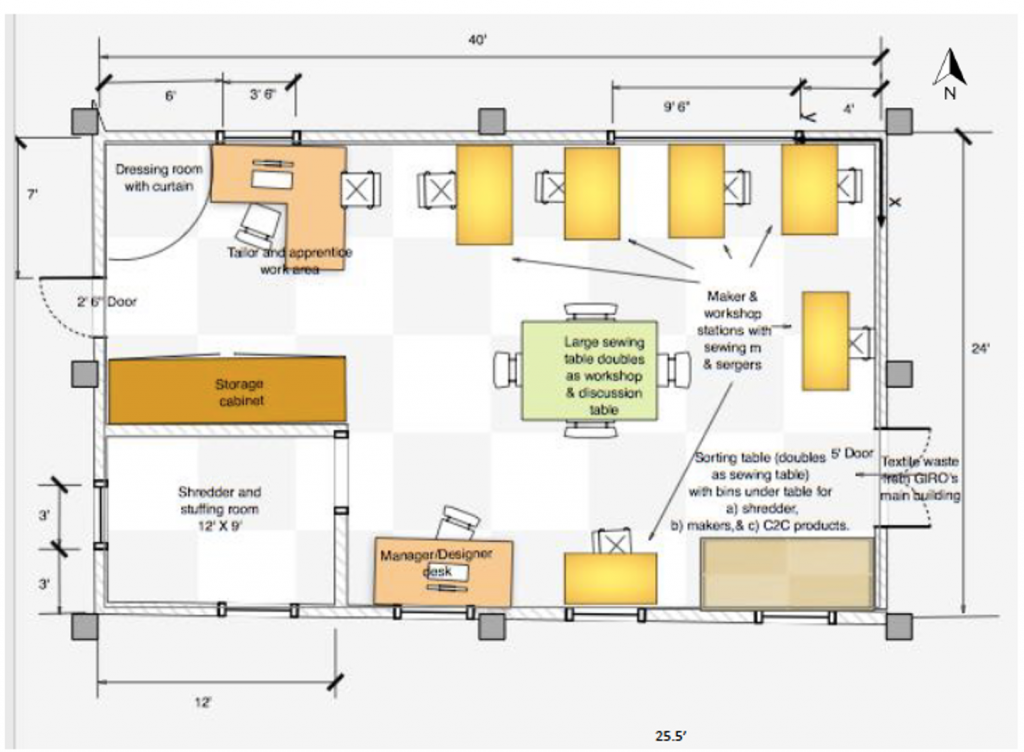GIRO C2C Threads Update
We have lots of exciting news to share since our last update in May. The textile project continues to develop organically through the support and collaboration with the Gabriola community, Regional District and beyond.
In our last update we shared the three winning designs from our designer competition that were selected as products that we believe have strong marketing potential as well as the capacity to go through a significant amount of the community’s textile waste. Those three products were: unpaper towels, stuffed applications (e.g., dog beds and cushions) and acoustic sound panels.
The other takeaway from the community process was the discovery that many of you were interested in having access to a maker’s space where you could rent stations with specialized equipment and attend regular workshops on rethinking textiles. This new piece led us to the design of a building that would incorporate both the C2C Threads reprocessing component and a maker’s space. To build this larger space we needed an additional $50,000 in funding, which we applied for and received from the Island Coastal Economic Trust (ICET). We are thrilled to receive this funding as it will help us to create a space that will support designer entrepreneurs and community tailors and sewers. The space will also house a repair person who will help islanders to extend the life of their clothing.
To celebrate and showcase the local designers’ creations we held a GIRO Fashion Show, Silent Auction and Fundraiser. For two months prior to the event, we gave the community access to the GIRO waste stream so that they could get busy creating pieces for the show. The event was held at the Commons on August 22nd with fashion show guru Dar Yuile overseeing 30 volunteer models strutting some amazing couture put together by the GIRO clothing department crew Yarrow Koontz and Sharon Kravitz. The show included a live auction of clothing pieces that were made by local designers, each piece highlighting the potential of rethinking and repurposing discarded textiles and silent auction tables displaying over forty repurposed clothing items and products that designers made.
The event was an opportunity for GIRO Board lead Fay Weller and I to talk about the name we chose for this initiative: C2C Threads. C2C stands for cradle to cradle, systems which circulate and recirculate materials in the economy rather than the current model of cradle to grave. We also shared some fashion facts:
- 20% – The average amount of global industrial water pollution that can be tied to garment production. (World Resources).
- 7000 liters – The approximate amount of water used to grow enough cotton to produce one pair of jeans. (Tree Hugger)
- 2700 liters – How much water it takes to produce the cotton needed for one t-shirt – that is almost three years worth of drinking water for one person. (WWF).
- 10% of global greenhouse gas emissions are caused by clothing and footwear production – this is more than all international flights and maritime shipping combined.
With such alarming statistics it is becoming clear that we have reached a point globally where the current take, make, waste linear system is broken.
From resource production, manufacture, distribution, sales, and end of life, we need to consider whether those steps are sustainable for the planet and if they aren’t then how can we change those processes. The C2C Threads initiative is a circular sustainable model where the textile waste will stay in a circular loop using the least amount of embedded energy to reprocess materials into new products.
For us as individuals it is so important to take responsibility where we can. Start by looking at your relationship with your wardrobe questioning your personal consumption habits.
When looking to buy a piece of clothing question “Do I need it?” If the answer is yes, then explore GIRO and other thrift stores first. They are a great place to find a one-of-a-kind piece and it supports the Reuse element of extending the life of a piece of clothing. If you aren’t into thrifting then research to find brands that sell clothing through a transparent, sustainable lens for all stages of manufacture, production, and distribution. There are some great brands emerging as well as well known brands that are pivoting to a more sustainable model. The main things to consider when making a purchase is to buy clothing that is well made (physically durable) and stays relevant (emotionally durable). These two elements will probably mean a higher price point but will also mean you end up with a closet of clothing that will last you for many years. If you purchase from a company that offer a repair service or life warranty (which many brands are now doing), then you are taking steps to put your dollars into companies that also care about the planet and are also giving dollars back to help conserve resources.
All our choices have an impact.
The fashion show event was also an opportunity to ask for your help. We are looking for $21,000 to help with the new building (specialized equipment, furniture etc.). We have raised $3,000 so far and thank everyone who has already generously donated dollars to this project. If you would like to donate, please visit our fundraising page for the project. Every dollar will help make this project a reality.
Many, many thanks to all the people who helped to make this event a success. There were almost fifty people who gave their time and energy to this project.


